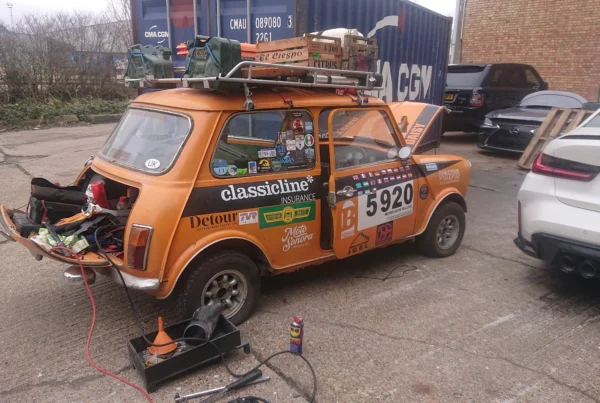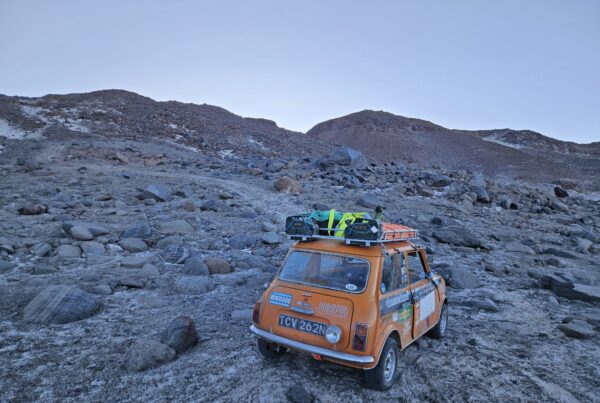What issues would you expect to face when taking two old classic cars to an altitude of almost 6,000 metres, on a volcano miles from civilisation? And how would you deal with them? ClassicLine’s resident road tripper, Ben Coombs explains…
Maintaining two classic cars, with a combined age of over 80 years, on a 4,000 mile road trip isn’t a challenge you should take lightly. Throw in a month of desert tracks and an ascent of the world’s highest volcano at the midway point, and you know it’ll be a challenge to keep the two cars running. It certainly was on the ClassicLine Insurance sponsored Mini6000 Expedition, anyway, not that that fact will surprise anyone as after all, neither the British Leyland-era Mini, nor the early ‘90s Range Rover were exactly bastions of reliability, even when new.
With this in mind, both cars on the trip carried an extensive tool kit, plenty of spare fluids for the cars, and a selection of the spare parts we thought we’d be most likely to need. Additionally, we carried what was affectionately known as a ‘bodge kit’. This consisted of a hefty selection of things which could be used to make temporary repairs – wire, duct tape, hose clamps, adhesives, electrical connectors, cable ties and the like. With this combination, we hoped to be able to keep the cars going during their three weeks in the wilderness.
It was the Range Rover which gave trouble first, combining a series of electrical glitches with a propensity to overpressurise its coolant and blow the cap off on the initial 1,500 mile drive across South America to the mountain. These overheating issues never really left the Range Rover, and had to be carefully managed for the whole trip, but it was on our arrival at the mountain that the issues really began to pile up, the combination of rough tracks and high altitude taking their toll on the cars.
Firstly, the fuel pump failed on the first 4,000+ metre-high pass we crossed, an issue which was traced to faulty wiring under the boot floor. Then, due to the heavy loads it was forced to carry on the mountain, both of the Range Rover’s rear shock absorbers quickly gave up the ghost, but more significantly, its alternator chose 4,350 metres as the altitude at which it would stop working. After much head scratching, we were able to fit the Mini’s spare alternator to the Range Rover, wire it up and get it working, a bodge which somehow lasted for the rest of the trip. Even if it’s higher current did set some of the previous owner’s dodgy cabin wiring on fire a few days later.
The mini’s issues were mostly less dramatic, but they still required attention. First amongst these was the difficulty of starting the engine at altitude, as unlike the fuel-injected Range Rover, the carburettor-fed Mini didn’t automatically adjust to the thinner air as we climbed. Therefore, we’d fitted the car with an air-fuel ratio gauge to allow us to fine tune the mixture on the mountain, and every move to a new altitude required a change of carburettor settings or jets, to help it adapt. Even this didn’t make running the Mini above 5,000 metres exactly routine however, and starting Daisy in the mornings was almost always a challenge, requiring many minor adjustments and on average, around 10 minutes of fettling.
Speaking of starting, once we were above 5,500 metres, the Range Rover wasn’t exactly easy to start either, as once off the fuel injection system’s mapping, the mixture would become too rich. One way around this was to start the car with the fuel pump relay out, and once it was spluttering on low-pressure fumes, refit the relay. It was only through innumerable tricks like this, that we were able to get the two cars as high as we did, though it was the starting issues which eventually stopped the Mini at an altitude of 5,920 metres – a combination of the thin air, and the fact the car was tilted upwards at over 20 degrees meant that the carburettor float stuck, resulting in an incorrect level, and making it impossible to start the engine and proceed upwards further.
And then there were the fluid leaks. The most stressful of these occurred at 5,840 metres, when the plummeting overnight temperatures meant the Range Rover’s antifreeze chose not to prevent freezing, and one of the freeze plugs in the engine block fractured. This left the 4×4 badly leaking coolant, near the summit of the world’s highest volcano, many miles from help. It’s at this stage that the bodge kit came into use – a lump of rubber was cut to shape, smeared with silicone sealant and jammed into the freeze plug hole, being held in place by a lump of wood, jammed against the adjacent engine mounting. This bodge held for 170 miles, getting the car down off the mountain and into the nearest town, where a proper repair could be carried out.
But it was the Mini which had, hands down, the most leaks. In the course of the trip, it began leaking oil from both the gear selector seal, and once that was fixed, the timing cover gasket took over. It suffered a split coolant pipe, and – we think – a faulty radiator pressure cap which vented steam whenever the engine was under load for much of the trip. The brake fluid leaked where the fine Atacama sand had gotten into the drums and damaged the piston seals, necessitating regular top-ups. And at 4,500 metres, even the fuel tank got in on the act, leaking from the seal where the temperature sensor locks in place, and flooding the boot in the process.
While this isn’t a complete list of the issues we faced with our classics on the mountain, it should give you an idea of the problems we faced in the course of our two month trip. But a wise person once said that, without problems to solve, there is no adventure. And so in that respect, we’re not complaining – if everything had gone smoothly, our South American road trip wouldn’t have been nearly as memorable. The myriad of issues came together to make the trip a serious challenge, and one which required us to nurse the cars closely from day to day, if they were to complete the drive.
But none of the above challenges were actually tackled while driving, so in the next instalment, we’ll be looking at what it was actually like, driving up the world’s highest volcano.













